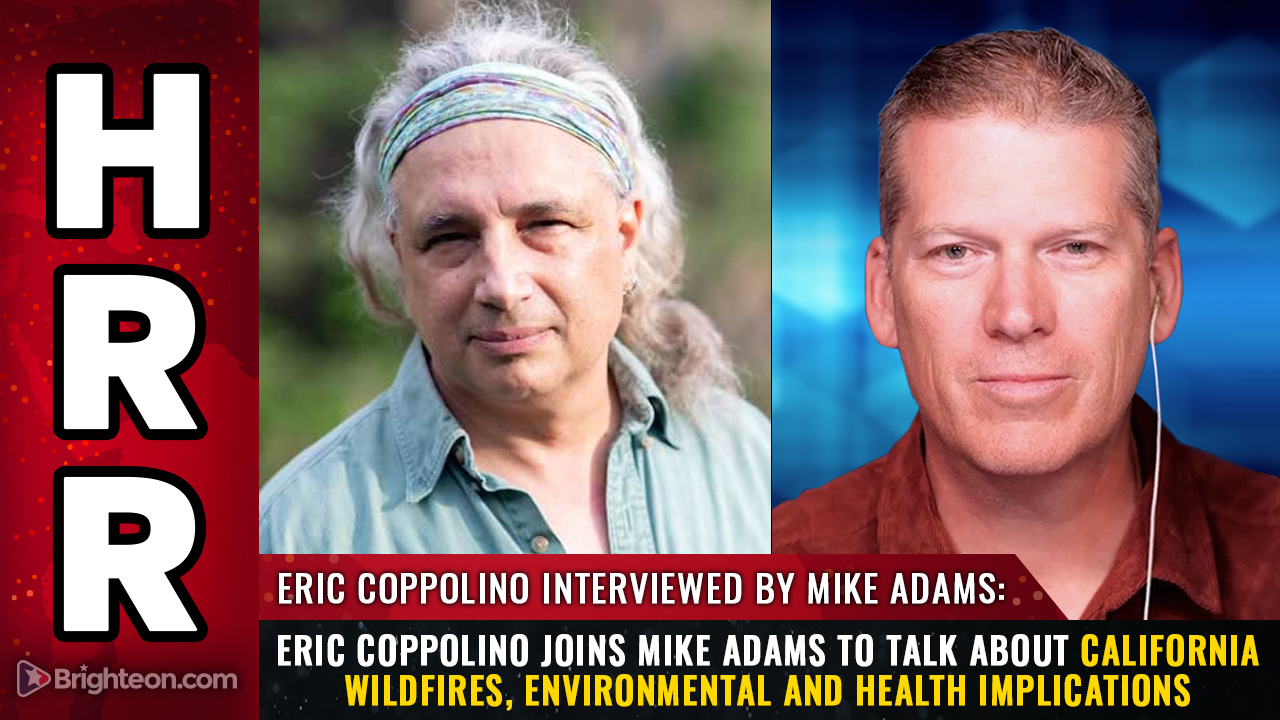California wildfires release lethal toxins: Environmental expert Eric Coppolino warns of long-term health impacts
By finnheartley // 2025-02-28
Tweet
Share
Copy

- Eric Coppolino, environmental expert, highlights that California's wildfires have transformed affected areas into toxic waste dumps due to the burning of 14,000-15,000 structures, releasing dangerous chemicals.
- The burning of homes and businesses releases a toxic mixture, primarily from plastics and PVC, turning these sites into hazardous environments and spreading contamination through hose-down water.
- Dioxins, highly carcinogenic chemicals released in femtogram quantities, pose significant cancer risks to large populations, contaminating waterways, aquifers, and topsoil, with long-lasting environmental effects.
- Coppolino criticizes the inadequate response by authorities, who treat the wildfires as regular house fires, lacking a comprehensive environmental assessment and remediation plans to address the widespread contamination.
- Coppolino calls for a thorough environmental assessment and proactive strategies to protect public health, advising residents to avoid contaminated areas and stay informed about health risks, emphasizing vigilance due to the long-term impacts of these toxins.
A Toxic Brew in the Ashes
Coppolino highlighted that the burning of homes and businesses in California released a toxic cocktail of chemicals, primarily from plastic and PVC materials. "Everywhere there were homes that burned, you now have essentially a toxic waste dump," Coppolino explained. "These homes are constructed largely of plastic, and many household items are made of some form of PVC. When these materials burn, they release a partially combusted brew of toxins that can be hose down, spreading the contamination further."Health Risks and Environmental Contamination
The extent of the contamination is particularly concerning due to the release of dioxins and other harmful chemicals. Dioxins, a group of 130 chemicals, are known carcinogens that can cause cancer even at extremely low exposure levels—measured in femtograms. "A part per trillion of a kilogram—femtograms—can cause cancer," Coppolino emphasized. "This level of exposure means that the toxins released from a single burning house could pose a significant cancer risk to a large number of people." Moreover, the toxins have spread into waterways, aquifers, and topsoil, creating a long-term environmental crisis. "The toxicity is now situated above the ground and in the topsoil, but it will also drain into the earth and the aquifer," Coppolino noted. "This means that the contamination will persist and continue to affect the ecosystem for years to come."Lack of Proper Response and Future Concerns
Despite the severity of the situation, Coppolino expressed frustration with the lack of adequate response from authorities. "The EPA and other regulatory bodies are treating these fires as ordinary house fires, not toxic events. There is no plan for a proper environmental assessment, such as removing and replacing topsoil to mitigate the contamination," he said. The impact of these toxins extends beyond human health, affecting animals and the food chain. "Dioxins are fat-soluble and bioaccumulate in the fat tissues of animals, including chickens, cows, and hogs. This means that these toxins can end up in eggs, milk, and meat, posing a risk to consumers," Coppolino warned. California's role as a major agricultural producer amplifies these concerns, raising the possibility of contaminated food products reaching a broader population.A Call for Action
As California residents and first responders continue to face the aftermath of the wildfires, Coppolino urges for a more comprehensive and proactive approach to address the toxic aftermath. "We need an honest and thorough environmental assessment to understand the full extent of the contamination," he said. "Only then can we implement effective strategies to protect public health and the environment." In the meantime, residents are advised to take precautions, such as avoiding close contact with topsoil and contaminated areas, and staying informed about potential health risks. "The long-term health impacts of these toxins are a serious concern, and we must remain vigilant and proactive in addressing them," Coppolino concluded. The California wildfires have not only left a trail of destruction but have also unleashed a toxic legacy that will require ongoing attention and action to mitigate its impact. Watch this full episode of the "Health Ranger Report" with Mike Adams, the Health Ranger, and Eric Coppolino as they talk about California wildfires, environmental and health implications. This video is from the Health Ranger Report channel on Brighteon.com.More related stories:
SUPER TOXIC SMOKE from California wildfires poses serious health risks California wildfires push home insurance to the brink: Will homes remain insurable? Community-Led Disaster Relief, Environmental Advocacy, and Autism Health Initiatives: Insights from Mike Adams, Tracy, and Steve Slepcevic Sources include: Brighteon.com PlanetWaves.fmTweet
Share
Copy
Tagged Under:
heart disease collapse toxins disaster toxic chemicals SHTF Southern California formaldehyde dangerous polycyclic aromatic hydrocarbons fine particulate matter carbon monoxide California wildfires badhealth badpollution PM2.5 health science wildfire smoke respiratory distress Pacific Palisades toxic smoke
You Might Also Like
Can Kennedy save kids from psychiatric ravage?
By News Editors // Share
Iowa lawmakers push to hold vaccine manufacturers accountable for injuries
By Cassie B. // Share
The role of mercury in autism: A deep dive into the cellular evidence
By Olivia Cook // Share
How one simple change can reduce your microplastic intake by 90%
By Cassie B. // Share
“Cancer Decoded” on BrightU: How to address inflammation and prevent chronic illnesses and cancers
By Jacob Thomas // Share
Recent News
Zelensky is actively sabotaging efforts to investigate corruption in his regime
By ljdevon // Share
Science validates coffee’s emotional power—but with one critical caveat
By avagrace // Share











